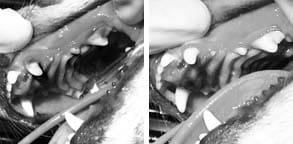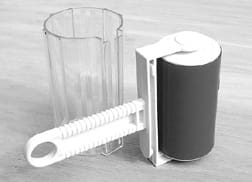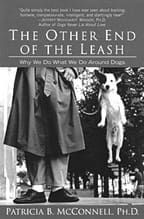by Nancy Kerns
For some reason, many dog owners are biased against buying canned food and feeding it to their dogs. Is it the odor of “potted meat”? The gelatinous, gloppy texture of some canned foods? The generic brown color and unidentifiable ingredients? The cost?
Whatever it is, get over it. Canned foods (even the low-quality ones) tend to contain fresher, higher-quality ingredients than dry dog food. They almost always contain a higher percentage of meat than kibble (which is limited to a maximum of less than 50 percent meat by the limitations of the extruding equipment).
Also, canned foods usually contain way fewer chemical additives than dry foods, if any at all. It would be wasteful to use artificial flavors in canned products; because of the moist, fragrant nature of the meat-based contents, artificial flavoring and other palatants are not needed to entice dogs.
Unlike dry foods, canned foods generally contain a negligible amount of preservatives; they are unnecessary in the sterile, sealed, oxygen-free environment that a can offers.
This does not mean the foods are free of preservatives altogether; some ingredients arrive at food manufacturing plants with preservatives already added to them to prevent spoiling en route to the plant. As long as the maker does not augment the food with additional preservatives, this “hidden” ingredient does not have to be declared on the food label.
Note that because they lack added preservatives, canned foods must be kept refrigerated after opening.
Canned food also tends to have a higher energy content, ounce for ounce. Its high moisture content is helpful for dogs with cystitis or kidney disease. The high moisture content can also help a dog who is on a diet feel full faster.
Finally, ask dogs what they’d rather eat and the answer will be unanimous: Open the can, man!
WDJ’s selection criteria
Of course, not all canned dog foods are full of fabulous, healthy ingredients. There are dozens of low-quality and hundreds of mediocre products on the market, and a small group of top-quality products.
Here’s how we determine which foods are which. We required the following for a product to make it into the running for our Top Canned Dog Foods:
• We eliminated all foods containing artificial colors, flavors, or added preservatives.
• We rejected any food containing meat by-products or poultry by-products. (Please note: Some of our past selections of years past do contain meat and/or poultry by-products. We don’t think fresh or frozen by-products are bad; they just aren’t as good as muscle meat. In order to winnow down our list to the very best foods possible, we no longer include foods that contain meat or poultry by-products.)
• By-product meal is another story. That’s the meal that remains following rendering (essentially, the tissues are boiled down and then dehydrated) fresh or frozen by-products. Regarding meat proteins used in commercial dog food, our order of affections goes something like this:
Best: Fresh or frozen “whole” meat (muscle tissue)
Good: Beef meal, chicken meal, or lamb meal
Scary: “Meat meal” or “poultry meal”
Run, don’t walk: “Meat and bone meal”
• We rejected foods containing fat or protein not identified by species. “Animal fat” is a euphemism for a low-quality, low-priced mix of fats of uncertain origin. These ingredients cost little, and may not be handled as carefully as more expensive commodities.
• We eliminated any food containing sugar or other sweetener. A food containing quality meats shouldn’t need additional palatants to entice dogs.
• We looked for foods with whole meat, fish, or poultry as the first ingredient on the food labels. Ingredients are listed on the label by the total weight they contribute to the product. Fresh or frozen whole meats contain lots of water, but in lower-quality products, water may be the first ingredient. (We know of one exception to this rule: Spot’s Stew, whose ingredient list starts with water and contains a whopping 88 percent moisture, but actually contains top quality ingredients. As the name suggests, the food is formulated this way so as to emulate a healthy stew, rather than a canned meat loaf.)
• We like it when a nutritious meat, poultry, or fish broth is used in place of water.
• We looked for the use of whole grains and vegetables, rather than a series of reconstituted parts, i.e., “rice,” rather than “rice flour, rice bran, brewer’s rice,” etc.
• Speaking of grain . . . We’ve discussed this many times, but there is nothing that says a canned food has to contain any grain. Grains are less expensive, and have lower-quality amino acid profiles than meat and poultry. And, unlike humans, dogs do not need carbohydrates to live; they can do fine with just protein and fat. We prefer foods with small (or nonexistent) amounts of grain.
• Bonus points for foods that offer the date of manufacture (in addition to the usual “best if used by” date), nutrition information beyond the minimum required by law.
• Organic ingredients bring a product to the front of the class. Dogs are exposed to far more chemicals than is healthy, so cutting out any unnecessary ones is brilliant.
Prove it!
This year, in addition to sharing our food selection criteria, and offering a short list of some superior products, we tried something new. We asked most (not all; we accidently omitted a few) of the companies on our past “Top Food” lists for some very sensitive information.
First, we asked them to tell us where their foods are made. We promised not to tell anyone; we just wanted to confirm that the manufacturing plants that they say make their foods are, in fact, physically equipped to handle the types of ingredients the foods are supposed to contain.
We also asked them whether they reveal this information to ordinary consumers. As we mentioned in “Made in a Secret Location” (January 2003) we like full disclosure. We worry when someone doesn’t want the public to know the origin of their products.
Finally, we asked them to provide us with documentation to substantiate any special claims they make about their ingredients. If they say they use organic ingredients, we wanted to see organic certification documents. If they hint that they use “human grade” ingredients (we’ll discuss that in a second), we asked to see USDA inspection certificates, or at least some receipts from growers. And if they said their products were made in a human-food facility, we really wanted proof of that; the only pet foods that can be made in a human-food plant must contain all “human-grade” ingredients.
Not all of the companies we sent the survey to returned it. Again, we missed some companies when we sent out the survey, and those are identified on the chart. We apologize – but the dry food reviews are coming up fast, and we’ll make sure we include them then.
“Human grade”
We’re afraid the above phrase is always going to have to wear quotation marks. You see, there is no accepted and codified definition of this phrase, when it comes to pet food, despite the fact that we all know what it’s supposed to mean: Real, top-quality people food.
But according to the law, if a truck headed for Safeway, full of frozen chicken intended for you and me, happens to get hijacked and taken to a licensed pet food manufacturing plant, the moment the truck’s doors are opened, that chicken is no longer “human grade.”
That’s just crazy, right? Even if an ingredient is the exact same stuff we’re eating, a pet food maker is not permitted, ever, to refer to it as “human grade” – not on the label, not on the company Web site, and not in the product literature. If he does, his product may be subject to a “stop sale” order by any state feed control official he has aggravated with his verbiage.
Wouldn’t it be useful to us, the consumers (well, buyers), to know whether a company uses the same sort of healthy, nutrition-packed ingredients we eat, rather than some sort of second-rate, castoff foods? Yes, of course. But there is currently no phrase or term accepted by the USDA and state feed control officials that can legally do the job.
This is why so many makers of top-quality foods hint about ingredients that “could have been put in product sold to humans,” or are “table-quality.” We’ll discuss this phrase and its permutations in a future issue. For now, we asked the food companies on our lists to send us documentation for any ingredients for which they made “special claims.”
Also With This Article
Click here to view “What’s the Best Dry Food For Your Dog?”
Click here to view “WDJ’s 2011 Dry Dog Food Review”
Click here to view “WDJ’s Approved Dry Dog Food List”
Click here to view “How to Shop Dog Food Labels”
-Nancy Kerns is Editor of WDJ.



















